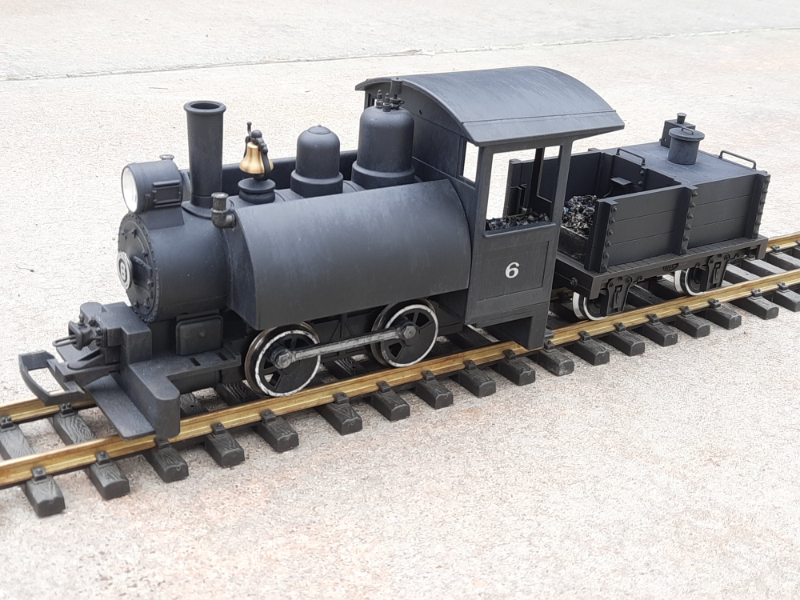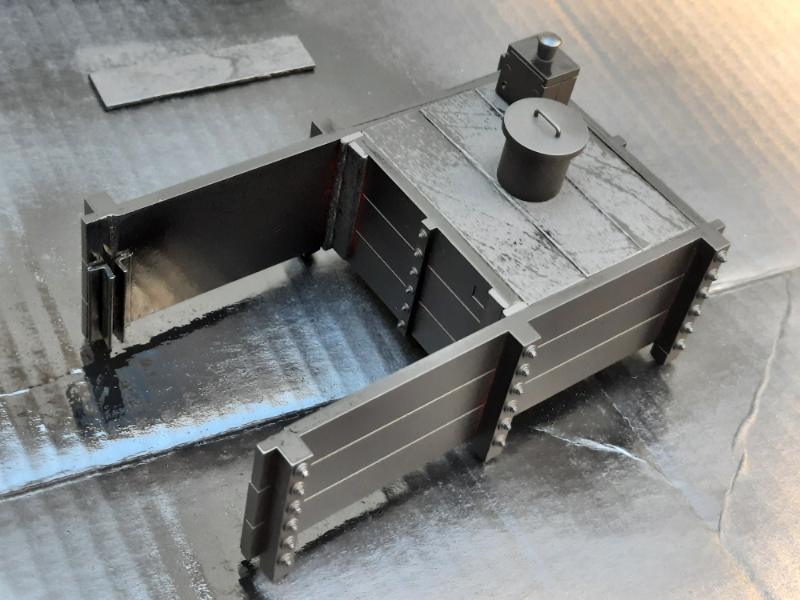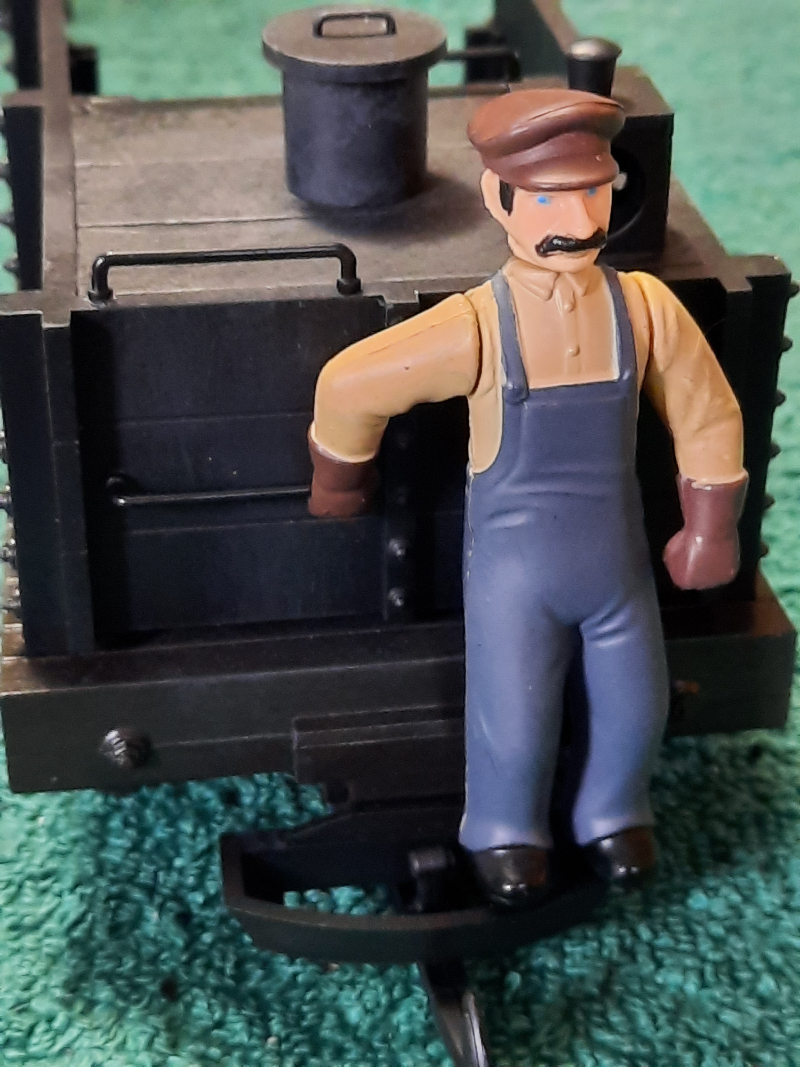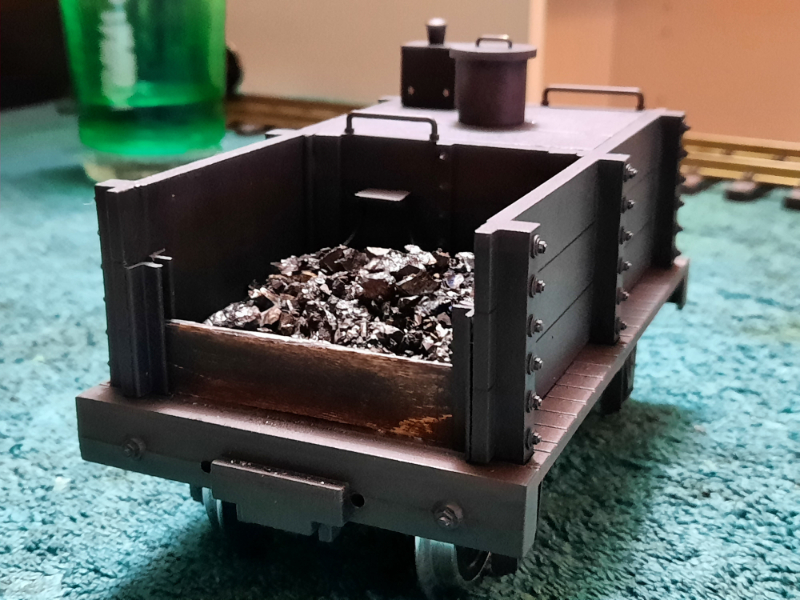Greetings to all friends and forum-goers near and far! After a long period of life weirdness and a move to another home, I bring forth a small tender kitbash for an also-small locomotive, being my inside cylinder 0-4-0ST built from a Bachmann Lil Big Hauler 0-4-0 that some of you may be familiar with.

This engine for a long time rolled solo on my former shelf railroad, with its little coal bunker in the cab as its fuel source, and while it does indeed operate, its very limited power pickup from a 4-wheel-base left much to be desired as far as running what could be construed as ‘smooth’ on any layout. The typical solution for such pickup difficulties is to tether a trailing car to the engine electrically, and while I’m not much of a fan of having one particular freight car stuck behind a locomotive, a tender made way more sense for a tiny engine with a tiny fuel supply. Such a tender would be a threefold innovation, extending the imaginary range of operation, extending the real contact footprint of the locomotive, and providing a space for a reverse light for backwards operation that industrial tank engines certainly frequently saw.

For the discerning eye, that is indeed a Hartland Mini Gondola, purchased new as an unassembled kit. With Hartland sadly defunct, anything produced by them has seen a considerable price increase due to the now-limited supply of their product.

The arrival of the unbuilt kit coincided with an arrival of LGB ball-bearing axles, wire sleeves for the axle’s contact pins, and a tender water hatch from Bachmann parts.

Initial scheming of things after basic press-fit assembly of the bright red gondola. At this point I found a spare LGB end-of-track light and already had a warm-white LED available for the rear headlight.

Visiting my father and his attic layout for a weekend hobby session, I was able to make use of his available power tools. The first step for making a tender from the gondola was to move the forward wall back to the middle, to open up space for coal and create a square water tank. Beneath the flat planks there are simple rectangles of scrap wood cut and sanded to length, allowing the top of the tank to sit nice and flush among the outer walls.

Boring holes for the water hatch and rear light allowed me to sink and adhere them into their places. Coinciding with this is the additional planking braces for the middle wall, and the front coal board and styrene L-shaped lengths there, creating a slot for coal boards to sit and retain the fuel during operation. Thankfully the saw marks from the wall relocation look like wear marks from coal boards being slid in and out and accidentally became a neat detail.

After a long evening of tinkering, I put the two together for an in-progress impression. Looks pretty good to my screwy eyeballs!

Internally, four wires come from both pickup axles and are routed through holes drilled through the baseplate, merging with the leads for the LED.

Taking apart the locomotive, revealed that the engine’s own power pickup from brass strips (blegh) simply routes to two little soldered spots on the board behind the rear axle. Alligator clips helped confirm a successful test of bridging power, and lengths of stiff black wire were soldered to these points, routed through two small holes drilled into the back of the motor block under the cab floor, and left to poke out in various weird directions while the tender saw continued work.

Like that of its counterpart, flat black does a lot for little industrial thingies. The IC 0-4-0ST is actually one of my more modern locomotives of my roster, hence the simple black paint.

Red spots must die.

The next task was figuring out how to link these two together, and after initially considering various drawbars, I found a length of thick old tarnished brass rod, and cut and tweaked it around to a big oval shape. Drilling two holes into the coupler tang of the locomotive, I fit the link into both holes, which forces it to remain straight, providing room for the hartland D-loop.

Initially I considered the idea of it being open to facilitate uncoupling. Then I figured with the wires between, uncoupling in a sense really wouldn’t happen ever under normal operating circumstances. The open link would also be likely to snag things, and it also had forced the footboard to be mounted backward temporarily. Pretty soon that arrangement became a nope.

Seeking closure, I squeezed the link shut. Permanence attained, and the footboard is just barely cleared.

Black paint largely dried, and another comparison.

Around this time I test fit a spare LGB deck plate from their 2015/2017 0-4-0s, to cover the gap of doom over the drawbar linkage and upcoming injector pipes. (Wires) This part was later affixed to the locomotive and sits clear of the planking of the tender.

A sunny and unsober afternoon later, I slathered weathering onto the tender. Sunlight amps up the color greatly.

Spare grab irons were mounted and a cut-and-filed Aristo caboose step found a home in the tender bunker. Two more were affixed to the footboard of the locomotive, visible in other images, to improve crew access into the cab.


Our big eastern European friend here is knocking onto the tank, testing for echoes.

Turns out this shop-built tender is fairly low and reserved in size, which is fine for the crew that needs to see the track beyond it.

Sealing the paint and weathering with Krylon Matte, it was time for the finishing touch of real coal. Chunks big and small were glued, fought, and glued some more into the coal bunker.

One thing about this tender, is that I never envisioned it being stuffed to the brim with a giant pile of bituminous. Half full is full enough for an engine that doesn’t stray far from home. Once the tender supply is depleted, IF it is depleted, the narrow bin in the cab would provide enough to get the engine to the fuel shed regardless.

Fully assembled, and out in the sporadic sun fighting through overcast clouds.

Testing and proper runtime with freight stock showed that while still a little jittery by itself and at slow speed, the engine is no longer ailed much by dirty track and frog-gaps of my R3/R4 switches, thereby largely solving the issue of poor pickup, while becoming a cool custom addition to the smallest dinky teakettle on my roster.

Thanks for reading!